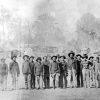calsfoundation@cals.org
Anson W. Hobson (1825–1882)
Confederate colonel Anson W. Hobson, a prominent physician, newspaper editor, and member of the Arkansas House of Representatives, served during the Civil War as company and regimental commander in the Third Arkansas Cavalry. Hobson led his troops through fifteen major battles and campaigns until the surrender of the Army of Tennessee on April 26, 1865, and parole at Chesterfield, South Carolina, on May 5, 1865.
Anson W. Hobson was born on April 14, 1825, in Athens, Georgia. Little is known of his childhood or parentage during his early years. He received a medical degree in 1848 from the University of Pennsylvania Medical Department in Philadelphia and had relocated by 1850 to Arkansas, establishing his practice in Camden (Ouachita County).
In 1857, he established the States Rights Eagle in partnership with R. L. Linscott, publishing it until the beginning of the war. In 1861, Hobson served as delegate to the Arkansas Secession Convention, and, although opposing secession, he enlisted in the Confederate forces once Arkansas seceded. Hobson was elected captain of Company H of Colonel Solon Borland’s First Arkansas Mounted Regiment of state troops and sent to Pittman’s Ferry in northeastern Arkansas. In July, the regiment was officially mustered into Confederate service and redesignated the Third Arkansas Cavalry due to another regiment already in service assigned as the First Arkansas Mounted Rifles.
Captain Hobson and the Third Arkansas moved east of the Mississippi as part of General Earl Van Dorn’s Army of the West in April 1862, participating in the Siege of Corinth, Mississippi, from April 29 to May 30. Most activity revolved around picketing and skirmishing, with no major battles. At the reorganization of Confederate forces May 26, 1862, Hobson was elected lieutenant colonel of the regiment, serving until the death of Colonel Samuel Earle in 1863.
At the Battle of Corinth, Mississippi, on October 3–4, 1862, Hobson was wounded in both arms and sent on detached service doing recruiting in Arkansas. Returning to the regiment in 1863, he was thrust into command upon the death of Colonel Earle during the March 5, 1863, Battle of Thompson’s Station. Hobson was wounded again at Franklin, Tennessee, in April 1863.
For the remainder of the war, Hobson and his regiment were part of Major General Joseph Wheeler’s cavalry corps. He led them through countless skirmishes, raids, and scouts in the major campaigns and battles, including the Tullahoma Campaign; Chickamauga; the Siege of Chattanooga; the Siege of Knoxville; the Atlanta Campaign (battles of Flat Shoals, Strawberry Plains, and Brown’s Mill); the Battle of Buck Head Creek, Georgia; the Savannah Campaign; and the final Carolinas Campaign (Battle of Monroe’s Crossroads). Colonel Hobson and the Third Arkansas were included in the surrender of April 26, 1863, and paroled at Chesterfield, South Carolina.
Returning to Camden, Hobson resumed publishing the Eagle until Federal forces destroyed his office in 1867, offended by some unknown statement made by him. He was elected to Congress in 1868 but was disallowed his seat by the Reconstruction Congress. Afterward, he published the daily paper for the forces of Joseph Brooks during the 1874 Brooks-Baxter War. He then relocated to Hope (Hempstead County) and founded the Star of Hope. In 1878, he was elected to the Arkansas House of Representatives and, in 1880, moved to Washington (Hempstead County) and founded the Press. Hobson returned to Hope and resumed publication of the Eagle until his death on February 9, 1882, at Washington. Hobson never married. He is buried at Rose Hill Cemetery in Hope.
For additional information:
Collier, Calvin L. The War Child’s Children: The Story of the Third Regiment, Arkansas Cavalry, Confederate States Army. Little Rock: Pioneer Press, 1965.
Willis, James. Arkansas Confederates in the Western Theater. Dayton, OH: Morningside Press, 1998.
Anthony Rushing
Benton, Arkansas
 Civil War through Reconstruction, 1861 through 1874
Civil War through Reconstruction, 1861 through 1874 Military
Military Politics and Government
Politics and Government



Comments
No comments on this entry yet.